高考英语复习之常见介词讲解
高考英语一轮复习:介词和介词短语
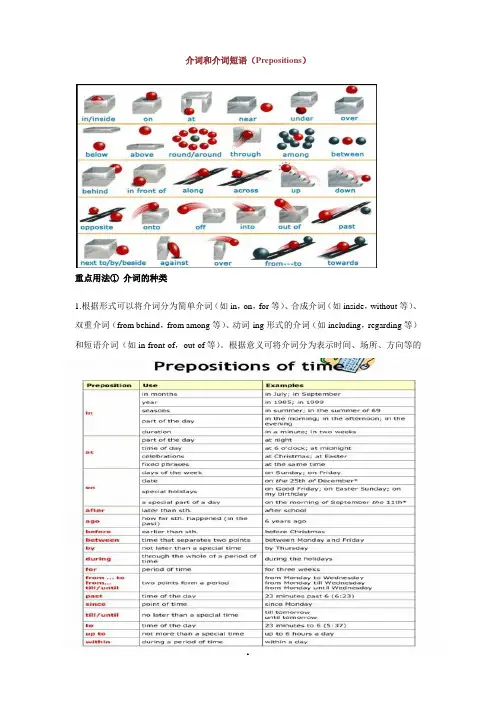
介词和介词短语(Prepositions)重点用法①介词的种类1.根据形式可以将介词分为简单介词(如in,on,for等)、合成介词(如inside,without等)、双重介词(from behind,from among等)、动词-ing形式的介词(如including,regarding等)和短语介词(如in front of,out of等)。
根据意义可将介词分为表示时间、场所、方向等的介词,介词在句中不能独立做成分。
2.表示时间的介词after在……之后before在……之前around大约……at在……时by到……为止in在……后on在……时till/until直到……3.表示场所、方向的介词across在……对面along沿着……at在……in在……里on在……上above在……上方under/below在……下面beside在……旁边behind在……后面before/in front of在……前面between在……之间among在……之间4.其他介词about关于;对于from从;自从with与……一起;用of……的;属于……的to向;到;对as担任;像;作为for对于;为了;给……besides除了……还有重点用法②表示时间的常用介词辨析用法:1.at表示时刻、时间的某一点;on表示具体的某一天,某一天的上、下午;in表示月、季节、年,泛指上午、下午、晚上(在一段时间内)。
at lunch在午餐时on Monday在周一in January在一月2.before表示“在……之前”;after表示“在……之后”。
I will be back before lunch.午饭之前我赶回来。
The nights start after half past five in winter.冬天的夜晚在5点半之后开始。
3.by表示“在……之前,截止到……”;until/till表示“直到……为止”;by表示到什么时候为止动作已经完成,而until表示动作持续到什么时候,在终止性动词的否定式中,二者通用。
高中英语介词知识点
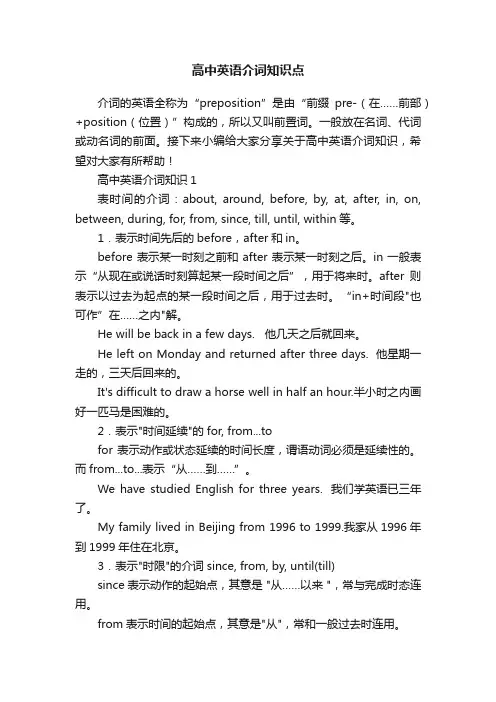
高中英语介词知识点介词的英语全称为“preposition”是由“前缀pre-(在……前部)+position(位置)”构成的,所以又叫前置词。
一般放在名词、代词或动名词的前面。
接下来小编给大家分享关于高中英语介词知识,希望对大家有所帮助!高中英语介词知识1表时间的介词:about, around, before, by, at, after, in, on, between, during, for, from, since, till, until, within等。
1.表示时间先后的before,after和in。
before表示某一时刻之前和after表示某一时刻之后。
in一般表示“从现在或说话时刻算起某一段时间之后”,用于将来时。
after则表示以过去为起点的某一段时间之后,用于过去时。
“in+时间段"也可作”在……之内"解。
He will be back in a few days. 他几天之后就回来。
He left on Monday and returned after three days. 他星期一走的,三天后回来的。
It's difficult to draw a horse well in half an hour.半小时之内画好一匹马是困难的。
2.表示"时间延续"的for, from...tofor表示动作或状态延续的时间长度,谓语动词必须是延续性的。
而from...to...表示“从……到……”。
We have studied English for three years. 我们学英语已三年了。
My family lived in Beijing from 1996 to 1999.我家从1996年到1999年住在北京。
3.表示"时限"的介词since, from, by, until(till)since表示动作的起始点,其意是 "从……以来 ",常与完成时态连用。
高中英语介词知识点
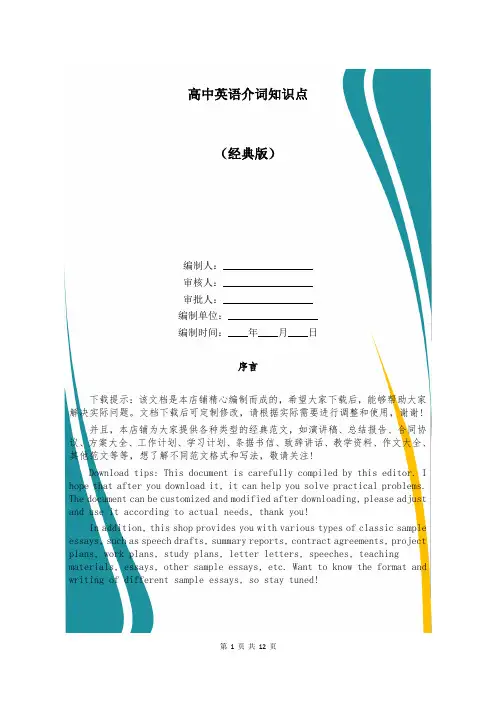
高中英语介词知识点(经典版)编制人:__________________审核人:__________________审批人:__________________编制单位:__________________编制时间:____年____月____日序言下载提示:该文档是本店铺精心编制而成的,希望大家下载后,能够帮助大家解决实际问题。
文档下载后可定制修改,请根据实际需要进行调整和使用,谢谢!并且,本店铺为大家提供各种类型的经典范文,如演讲稿、总结报告、合同协议、方案大全、工作计划、学习计划、条据书信、致辞讲话、教学资料、作文大全、其他范文等等,想了解不同范文格式和写法,敬请关注!Download tips: This document is carefully compiled by this editor. I hope that after you download it, it can help you solve practical problems. The document can be customized and modified after downloading, please adjust and use it according to actual needs, thank you!In addition, this shop provides you with various types of classic sample essays, such as speech drafts, summary reports, contract agreements, project plans, work plans, study plans, letter letters, speeches, teaching materials, essays, other sample essays, etc. Want to know the format and writing of different sample essays, so stay tuned!高中英语介词知识点介词的英语全称为“preposition”是由“前缀pre-(在……前部)+position(位置)”构成的,所以又叫前置词。
高三英语(外研版)总复习语法课件:专项语法突破(7)介词与介词短语
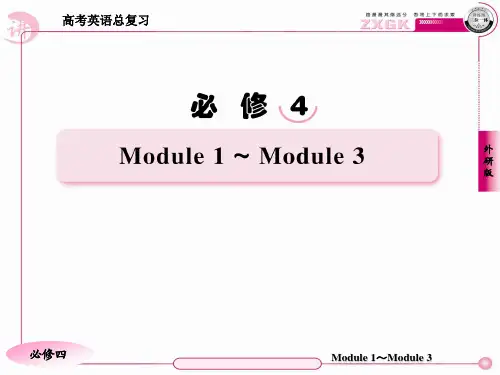
高考英语总复习
22 ○
(much) to one's (great) joy/satisfaction/surprise/
regret/anger 令某人(非常)高兴/满意/惊讶/遗憾/生气的 是„„
23 ○ of(great/much)
外 研 版
help/use/importance/value =(very)
外 研 版
必修四
专项语法突破(七)
高考英语总复习
Nobody else but/except me could answer such a question. 除了我,谁都不会回答这样的问题。 Apart from(=Besides) the cost, it will take a lot of time. 除了花费不谈,还要占用很多时间。 It is a good book apart from (=except for) some misprints. 除了有些印刷错误,这本书很好。
外 研 版
必修四
专项语法突破(七)
高考英语总复习
方法三:注意掌握积累固定短语中的介词用法,如: 介词+名词,动词+介词,形容词+介词等。另外还要注 意分析、比较介词的习惯用法:beyond repair (无法修理); out of the question (不可能);out of question(毫无疑问); under repair/construction (正在修理中/建设中); run out of (花光了„„;用尽了„„)等等。
外 研 版
必修四
专项语法突破(七)
高考英语总复习
剖析:C
句意:这项新的税收政策仅影响到年收入
超过人民币 12 万的人, 换句话说, 是那些富人。 由题干知, “年收入超过 12 万的人”和“富人”是同位语,故用 in other words“换句话说”, 用来做进一步解释说明。 the by way“顺便提及”;as a result“结果”;as a manner of “作为一种风格/方式”。
介词用法总结-高考英语知识点
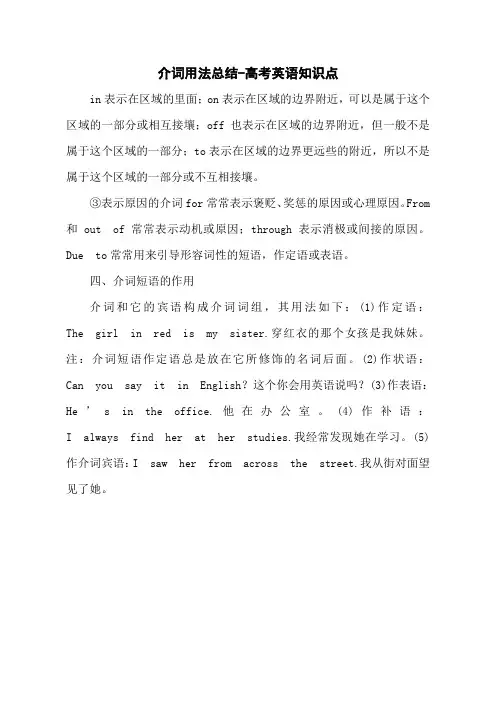
介词用法总结-高考英语知识点
in表示在区域的里面;on表示在区域的边界附近,可以是属于这个区域的一部分或相互接壤;off也表示在区域的边界附近,但一般不是属于这个区域的一部分;to表示在区域的边界更远些的附近,所以不是属于这个区域的一部分或不互相接壤。
③表示原因的介词for常常表示褒贬、奖惩的原因或心理原因。
From 和out of常常表示动机或原因;through表示消极或间接的原因。
Due to常常用来引导形容词性的短语,作定语或表语。
四、介词短语的作用
介词和它的宾语构成介词词组,其用法如下:(1)作定语:The girl in red is my sister.穿红衣的那个女孩是我妹妹。
注:介词短语作定语总是放在它所修饰的名词后面。
(2)作状语:Can you say it in English?这个你会用英语说吗?(3)作表语:He’s in the office.他在办公室。
(4)作补语:I always find her at her studies.我经常发现她在学习。
(5)作介词宾语:I saw her from across the street.我从街对面望见了她。
英语高考介词高频考点
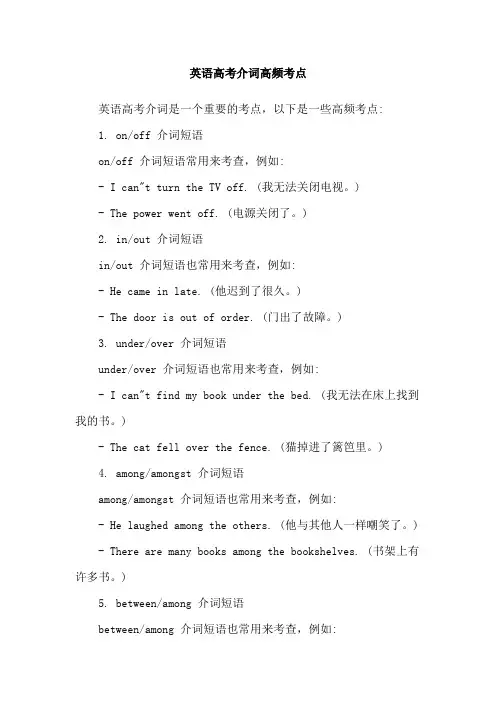
英语高考介词高频考点英语高考介词是一个重要的考点,以下是一些高频考点:1. on/off 介词短语on/off 介词短语常用来考查,例如:- I can"t turn the TV off. (我无法关闭电视。
)- The power went off. (电源关闭了。
)2. in/out 介词短语in/out 介词短语也常用来考查,例如:- He came in late. (他迟到了很久。
)- The door is out of order. (门出了故障。
)3. under/over 介词短语under/over 介词短语也常用来考查,例如:- I can"t find my book under the bed. (我无法在床上找到我的书。
)- The cat fell over the fence. (猫掉进了篱笆里。
)4. among/amongst 介词短语among/amongst 介词短语也常用来考查,例如:- He laughed among the others. (他与其他人一样嘲笑了。
) - There are many books among the bookshelves. (书架上有许多书。
)5. between/among 介词短语between/among 介词短语也常用来考查,例如:- I can"t find my keys between the sofa and the wall. (我无法在沙发和墙上找到我的钥匙。
)- The children played happily among the flowers. (孩子们在花丛中玩得很开心。
)这些介词短语在英语高考中常常会出现,考生需要熟练掌握它们的含义和用法,以便在考试中更好地应对。
高考英语二轮专题复习精品语法:冠词名词代词形容词副词介词汇总讲解及练习
冠词1.不用冠词的情况(1)专有名词、物质名词、抽象名词、人名、地名等名词前,一般不加冠词。
China , America, Smith(2)季节、月份、星期、节日、假日、一日三餐名称前一般不加冠词。
March, May Day, National Day, Children’s Day, Women’s DayHave you had supper?Spring is the best season of the year.(3)称呼语及表示头衔职务的名词作宾语、补语及同位语时,一般不加冠词。
What’s this, Father? We made him our chairman.Professor Li.(4)学科名称、球类、棋类名称前不加冠词。
Do you study physics?He likes playing football/chess.(5)复数名词表示泛指一类人或事物时前不用冠词。
They are peasants/ workers.(6)在与by连用的交通工具名称前不加冠词。
by car, by bus,by bike, by train, by air/ water/ land但:take a bus, come in a boat, on the train/ bus需注意。
(7)某些固定词组中不用冠词。
①名词词组中:husband and wife, brother and sister, body and soul, day and night, knife and fork②介词词组中:to(at, from) school, in (to)class, in (to,at, from)university(college),to(in, into, from)church, to(in,into, out of)prison(hospital, bed), to(at, from, out of)work, to(in, from) town,at (from)home, to(at)sea, at night(noon, midnight), by car (bus, bicycle, plane), on foot注意:在有些词组中,有无冠词含义不同。
高中英语 常见的介词总结
高中英语常见的介词总结高中英语常见的介词总结1. in-in 表示在某个具体地点或范围内- e.g. I live in Beijing.- e.g. The book is in my bag.2. on-on 表示在某个高低平面或表面上- e.g. The cup is on the table.- e.g. She is sitting on a chair.3. at-at 表示在某个时间、地点或某种状态下- e.g. Let's meet at the park.- e.g. I'll call you at 8 o'clock.4. by-by 表示通过某种方式、方法或交通工具- e.g. He goes to work by car.- e.g. Please send the document by email.5. for-for 表示为了某个目的、目标或对象- e.g. This gift is for you.- e.g. I bought this book for studying.6. with-with 表示和某个人、物或状态一起- e.g. I went to the park with my friends. - e.g. She is playing with her dog.7. of-of 表示属于、关于或由某人或事物引起- e.g. That is the book of my friend.- e.g. The story is about a detective.8. to-to 表示移动、方向或目的- e.g. Let's go to the library.- e.g. She gave a present to her sister.9. from-from 表示出发点、来源或关系起始- e.g. The letter is from my teacher.10. with-with 表示附带、伴随或使用某物- e.g. I want a coffee with milk.- e.g. He wrote the note with a pencil.这些是高中英语中常见的介词总结,希望能对你有所帮助。
第02讲代词介词和介词短语(讲)高考英语一轮复习(全国通用)(学生版)
第02讲代词、介词和介词短语(讲)【考纲考情】一、代词考点,是英语高考常考点之一。
在高考中主要考查点有:人称代词、物主代词、反身代词、代词宾格、形式主语或宾语的it、强调句中的it等。
应特别注意以下几点:①对代词的指代或替代功能的考查;①对不定代词意义用法的考查;①对反身代词的考查;①对代词格的考查;①对it作形式主语或宾语的考查、强调句中的it的考查;①对含有代词的短语考查。
代词在高考中的命题形式主要有:语法填空;完形填空;改错;书面表达。
二、介词(短语)考点,是英语高考必考点之一。
在高考中主要考点有:考查介词的基本用法和固定搭配;介词(短语)的正确运用以及与形容词或动词搭配。
对介词(短语)的考查常出现在高考试题中的语法填空、完形填空、改错、书面表达中。
【考点梳理】一、代词(一)、人称代词人称代词用来代替人或物,有人称、数和格的变化,其形式如下:(二)、物主代词物主代词:在句子中作定语修饰名词的为形容词性物主代词;在句子中相当于“形容词性物主代词+n.”的为名词性物主代词,通常在句子中作主语或宾语,如下表:(2)“of(介词)+名词性物主代词(或名词所有格)”构成双重所有格,如:a friend of mine (my father's)我(我父亲的)朋友中的一个。
(3)形容词性物主代词与own连用表示强调,one's own ... =... of one's own。
(4)某些固定结构中常用定冠词代替物主代词。
take sb by the arm, be wounded in the leg。
(三)、指示代词(四)、不定代词1.one, ones, the one, the ones, those, it, that的区别2.the other, other, another, others的区别3.either, both, neither, all, none, any的区别4.none, no one与nothing的区别(1)none指人或物,表特指,可与of短语连用,回答疑问词how many/much引起的问句。
【高中英语】高中英语:介词的主要用法讲解
【高中英语】高中英语:介词的主要用法讲解1、介词的主要用法:介词是虚词,不能单独使用。
在介词之后,通常有一个名词或代词(宾语)或其他词类、短语或分句相当于一个名词作为宾语,构成一个介词短语。
有些介词是由两个以上单词组成的短语介词,如outof、becauseof、awayfrom、ontopof、everfash、nextto、accounto、infontof等。
2、介词的分类表:(见下表)位置(位置、范围)介词:在前面、前后、对面、后面、对角、靠近、沿着中间、围绕在四周、在四周、在前、在后、在后、在旁边、在中间、在下、下、下、从内、内、内、近、其中,上、外、外、上、下、上、上、上、下、前、近、中、中、候的结束。
方向(目标趋向)介词:across横越...,against对抗...,along沿着...,around绕着...,round环绕...,at朝着...,behind向…后面,etween…and…从…到...,by路过/通过...,down向…下,for向...,from从/离...,in进入...,into进入...,inside到...里面,near接近...,off脱离/除...,on向...上,outof向...外,outside向....外,over跨过...,past经过/超过...,through穿过...,to向/朝...,towards朝着...,onto到...上面,onto到...上面,up向...上,awayfrom远离...时间介词:About,After,at,before,by,until,interval,for,from,in;之后(多久),在(某一天),过去。
(小时),因为。
(到目前为止),通过。
(句号),直到。
,直到直到(到下一刻),从那时起,在开始的时候,Atdidof在结尾,在中间,在时间的中间。
方式介词:as作为/当作...,by用/由/乘坐/被...,in用…(语言),like与…一样,on骑(车)/徒(步),通过(收音机/电视机),over通过(收音机),through通过...,with用(材料),用(手/脚/耳/眼),without没有…涉及介词:关于,除了For/关于。
- 1、下载文档前请自行甄别文档内容的完整性,平台不提供额外的编辑、内容补充、找答案等附加服务。
- 2、"仅部分预览"的文档,不可在线预览部分如存在完整性等问题,可反馈申请退款(可完整预览的文档不适用该条件!)。
- 3、如文档侵犯您的权益,请联系客服反馈,我们会尽快为您处理(人工客服工作时间:9:00-18:30)。
高考英语复习之常见介词讲解. 概述介词又称作前置词, 是一种虚词, 不可在句中单独作句子成分.介词用于名词、代词前, 也用于相当于名词的其他词类、短语或从句前, 表示与其他成分的关系.二.介词的种类英语中介词的数量并不多, 大致可分为三类.1. 简单介词(只有一个单词) in,of,on,at,by,over,under,past,below2. 复合介词(由两个介词合成为一个词)into,outside,within,onto,inside,without3. 短语介词(由两个或两个以上的单词结合而成) because of,outof,instead of,according to,in front of,along with三.介词的宾语介词通常要带有自己的宾语, 介词宾语有下面几种.1. 名词、代词作介词宾语2. 动名词或动名词短语作介词宾语3. 不定式或不定式短语作介词宾语4. 从句作介词宾语5. 数词作介词宾语6. 副词作介词宾语7. 介词短语作介词的宾语其他如:till after supper 直至晚饭后from among the crowd 从人群中from among these 从这些中from below the river 从河的下游from under the books 从这些书的下面四.介词短语的作用1. 作定语介词短语作定语时必须放在被修饰词的后面.2. 作状语3. 作表语4. 作宾语补足语五.表示某一时间或时间点的介词表示时间的介词有:in,after,during,for 宀表示一段时间(时间段)at,on T表示一点时间(时间点)by,till,until 宀表示期限(截止到)through宀表示期间within T表示在一段时间内before宀表示在某一时间之前after宀表示在某一时间之后from,sinee宀表示时间起点1.atat 用于表示时间、时刻的某一点.再如:after 表示以过去时间为起点的一段时间以后,因此通常与过去时连用;in 表示从现在算起的一段时间以后,因此通常用于将来时或含有将来意义的句子He eame baek after three days. 3 天后他回来了。
I 'll eome baek in three days. 我3 天后回来。
at ten o 'eloek 在10 点钟at 8:10 在8 点10 分at night 在夜间at two sharp 在两点整at half past five 在5 点半at dawn 在黎明at daybreak 在黎明at sundown 在日落时at midnight 在午夜at还可表示”在... 岁(时)”.He went to school at the age of six. 他6 岁上学.2.onon 用于指特定、具体的某天、某天的上午、下午、晚上也用于星期几.再如:on Friday 在星期五on Friday afternoon 在星期五的下午on October 1 在10 月1 日on a cold night 在一个寒冷的夜晚on New Year 's Day 在新年on one's arrival 在某人到达时on one's return 在某人返回时on/at the weekend 在周末on August 20,2004 在2004年8月20日on the night of the 3rd 在3 日夜里on the afternoon of Monday 在星期一下午on a fine evening 在一个晴朗的晚上on the morning of July the first 在7 月1 日上午on a warm evening in May 在5 月的一个暖和的晚上in the evening 在晚上in the morning 在上午on a winter evening 在一个冬天的晚上on the morning of March 2nd 在3 月2 日的上午3. by 和before1) by表示”在……前,截至(到)……”,指一个时间点,句中谓语动词常用完成时态2) before 表示”在……之前” , 指在某一时间点之前4. after, in 和since1) after 表示”在……之后” , 表示以过去时间为起点的一段时间以后,因此通常与过去时连用;in 表示从现在算起的一段时间以后,因此通常用于将来时或含有将来意义的句子He came back after three days. 3 天后他回来了。
I 'll come back in three days. 我3 天后回来。
I think he can come back in three days. 我想他3 天后可以回来。
2) after 除与时间段连用外,还可与时间点连用,此时则可用于将来时in 不能与时间点连用He will arrive after five o ' clock. 他5 点钟以后到。
He said that he would be here after 6 :00. 他说他六点钟之后会来这儿.My father is coming back from England in about a month.( 我父亲大约一个月以后从英国回来)3) after可以与某些表示活动的名词连用,表示“在…之后”in 不能这样用after school 放学后after class 下课后after the meeting 散会后after liberation 解放后2)since 表示”自……以来” ,指过去某一时间延续到说话时, 句中谓语动词用现在完成时I ' ll live in a new house after May 1. 5 月1 日后, 我将住在一所新房子里.(after 所在主句中的时态用将来时或过去时)I have lived in a new house since May 1. 自5 月1 日以来, 我一直住在一所新房子里. (since 所在句中的时态用完成时)5. till/until 和from …to1) till/until 表示”直到……为止”,指动作或状态延续到某一时间终止, 不再延续下去2) from…to表示时间”从……至……”,指从一个时间点到另一个时间点六. 表示一段时间的介词这类介词有:after,in,during,for,within,through1. after 和inafter 和in 均可用于一段时间之后, 表示”在……之后” , 但有区别.1) ” after+ 一段时间” 指以过去时间为起点的一段时间之后, 常与过去时连用2) ” in+ 一段时间”指从说话时算起将来的一段时间之后, 常同一般将来时或过去将来时连用They' l l build another bridge in a few years. 再过几年他们将再造一座桥.They built another bridge after a few years.过了几年他们又造2. duringduring表示”在.... 期间”,指在一段时间之内.再如:during the war 在战争期间during the meal 吃饭时during the holiday 在假期里during the trip 在旅游中during the day 在白天during my absence 在我不在时3. forfor 表示”多长时间, 某动作或状态延续多长时间” .4. withinwithin 表示”多长时间内, 不超过多长时间” , 没有时态的限制. within强调”在 .... 时间内”,可用于各种时态.in以现在时间(说话时)为起点,强调”在……后”,一般只用于将来时.He will come back within a few days. 他将在几天之内回来.He lives within 20 minutes'walk. 他住的地方走20 分钟就到。
He will come back in a few days.他将在几天之后回来5. throughthrough表示在..... 整个期间, 自始至终” .七. 表示位置、方向的介词表示位置的介有:at,in,by,near,between,under表示方向的介词有:to,into,out,out of,across,along,through1. at,in 和on1) at 表示在某地点, 强调在某个位置点at 也用于街道号码前.另外,在road 和street 前,英式英语用in, 而美式英语用on.She lives at 78 Nanjing Road. 她住在南京路78 号.She lives on/in Nanjing Road. 她住在南京路.She lives in/on Queen Street. 她住在女王街.arrive at 后接较小的地方, 如车站、学校、机场等;arrive in 后接较大的地方, 如城市、国家等.They arrived at the airport at 9:30. 他们9 点半到达机场. They arrived in Shanghai at noon. 他们中午到达上海2)in 表示”在某区域内,在一个空间的内部,在……里面”There is a post office at the corner of the street. 有一个邮局 .( 指一个位置点 )There is a table in the corner of the hall. 子.( 指一个空间内 )两个地名连用时 , 小的用 at, 大的用 in He arrived at London in English last week. 敦. They will meet at Washington in America. 顿会面 .3)on 表示”在……上” ,并与之相接触 He put his clothes on the floor. 他把衣服放在地板上 .There is a small hole in the floor.地板上有一个小洞 .There is a notice on the box. 盒子上有一张说明 . There is a pen in the box. 盒子里有一支钢笔 .There are some apples on the tree. 树上有一些苹果 .( 树上所长之 物)There are some birds in the tree. 树上有一些鸟 .( 树外之物 )比较英式英语和美式英语的不同介词用法在街角处 大厅角上有一张桌他上周到达英国伦他们将在美国的华盛在路上on the road (美) in the road (英)在街上on the street ( inthe street (在周末on the weekendat the weekend (英)在这个队on the team (美)in the team (英)in the tree 在树上(多指树外之物, 如鸟、猴子等) on the tree 在树上(多指树上长的东西, 如苹果、橘子等)2. under 和belowunder表示”在 ... 的正下方”,指垂直上下.below表示”低于某物”,只表示位置低于,但不一定是在正下方. There is a boat under the bridge. 桥下有一条船.There is a boat below the bridge. 桥的下游有一条船.3.over 和aboveover表示”在... 垂直的上方”,与under相对;above表示”在……的上方”,指高于某物,但不一定是正上方,与below 相对.An airplane flew over our head. 一架飞机从我们的头顶上飞过.(垂直在头顶上)An airplane flew above the clouds. 一架飞机在云端上面飞行.(云层的上面)4. between 和among1) between表示”在... 之间”,一般用于两者之间2) among表示”在.. 中间”,一般用于三者或三者以上之间强调三者以上每两两之间也要用between.He doesn't eat anything between breakfast,lunch and supper. 早、中、晚三餐间他不吃任何东西.There are some differences between the three of them. 他们三者之间有一些差别.5. behind,after,in front of 和before1) behind 表示”在... 后面”,in front of 表示”在 .... 前面,在.... 前部” , 两者均表示静态的位置in the front of 表示”在... 前部”,指在某物内部的前部.The driver sat in the front of the car. 司机坐在车的前部The teacher stood in the front of the classroom. 老师站在教室的前部.2) after表示”在.... 后面”,表示动态的位置,也表示次序;before表示”在.. 前面”,可表示动态或静态的位置6. by,beside,near 和next to 1).............................................. by和beside均表示”在旁边”,常可换用2) near表示”在... 附近”,表示的距离比by和beside稍远些,也时常换用3) n ext to 表示”紧靠... 的旁边”7.in,into 和out of1) in表示”在 .. 内”,常指静态2) into 表示”进入” , 指由外到内, 指动态, 常同walk,run,fly,go,come 等连用3) out of表示”从.... 里面向外”,指动态,反义词是into8.on 和onto1) on表示”在.. 上”,指在表面上2) onto表示”到……上面”,常同移动意义的动词连用,女口:jump,climb,lift 等9. from 和off1) from 表示”距离, 分离” , 指离开某个点2) off 表示”和……分离, 自……下来” ; 指脱离一个面或一条线10. across 和through1) across 表示”横过” , 指横穿过一个平面或一条线2) through 表示”穿过” , 指从某个三维空间或地区内穿过, 从这端进入从那端出来11. to,towards 和for1) to 表示”到……目的地” , 强调到达目的地2) towards 表示”向……方向” , 指方向, 不包含到达目的地的概念John drove towards Shanghai. 约翰开车往上海方向去John drove to Shanghai. 约翰开车去了上海. 3)............................ f or 表示”向,往”,常同leave,start,set out 等连用12. round,around,about 和along1) round和around均可表示”围绕,在... 四周”round 和around 作为介词都有”围绕”的意思, 表示静态的位置或动态的动作. 英式英语多用round, 美式英语多用around.2) about 表示”各处, 到处” , 指范围较模糊的”附近”They sat about the desk. 他们坐在桌子附近.They sat around/round the desk. 他们围着桌子坐.3) along 表示”沿着, 顺着”八. 表示方式、方法和材料的介词这类介词有:by,in,with,without1.byby表示”用,以,靠,通过……方法”.乘”公共汽车”可有 3 种表达法: 我们将乘公共汽车去公园:We'll go to the park by bus.We'll go to the park on a bus.We'll go to the park in a bus.“步行”要说on foot, 不可说by foot 或on feet.2.in in 表示用什么材料, 如墨水等, 也表示用什么语言.3. withwith 表示用某种工具或方法.with 和in 均可表示”用” ,with 后的名词前要加冠词或代词, 而in 后的名词前不可加冠词或代词.她用铅笔写了那封信:She wrote the letter with a pencil.She wrote the letter in pencil.4. withoutwithout 表示”没有,无,不用”,是with 的反义词.九. 几组介词用法比较1.of 和from1) of表示”(属于)……的”,指所属关系、种类、数量等2) from 表示”来源,起源,来自” , 也表示”原料”make- of和make-from均表示”由..... 制成”,但有区别.制造出来的东西还看得出原料,用make-of;看不见原料,用make-from.The door is made of wood. 这门是木头做的.This kind of wine is made from grapes. 这种酒是用葡萄酿制的.2.like 和as1) like 表示”像, 和--一样”2) as 表示”作为, 当作”3.against 和for1)against 表示”反对” , 也表示”靠着”2)for 表示”支持, 赞同”十. 介词同动词、名词、形容词构成的惯用词组1. ”动词+介词”构成的惯用词组1)”动词+介词”构成的惯用词组“动词+介词”构成许多固定搭配, 已成为惯用词组.2)动词与不同的介词搭配有些常用动词,如get,look,go,run,call,speak 等, 还可同不同的介词搭配, 表示不同的含义.getget to the airport 到达机场get out of the house 走出屋外(out of 可看作双词介词)get into bed 上床get through the work 做完工作get on the bus/ship/train/plane 上公交车/船/ 火车/飞机get off the bus/ship/train/plane 下公交车/ 船/ 火车/ 飞机get into a car/boat/canoe 上车/小船/ 小舟get out of a car/boat/ca noe 下车/小船/小舟(out of 可看作双词介词)looklook for a key 寻找一把钥匙look at the blackboard 看黑板man 照看一个老人look into the matter 调查那件事 look through the newspaper 浏览一下报纸look up a word in the dictionary在词典中查一个单词look around the house 在房屋四周查看 look like a monkey 看起来像一只猴子gogo over the lesson 复习功课 go for a walk 去散步go into the matter 调查那件事 runrun across Mary 偶然遇见玛丽 run after a hare 追赶一只野兔run into a tree 撞到一棵树上 run against the wall撞到墙上run off the trails ( 火车)出轨 2. ”形容词 +介词”构成的惯用词组1) 形容词 +about 2) 形容词+at 3) 形容词 +for 4) 形容词 +fromlook into the mirror 照镜子 look after an oldgo by train 乘火车去 go to the west 去西部 go on strike 罢工go along the road 沿路走去go on a journey/trip 去旅行go about the work 着手做这项工作5) 形容词+in6) 形容词+of7) 形容词+to8) 形容词+with 有些形容词可以与不同的介词搭配, 表示不同的含义.He is anxious about the children. 他挂念孩子们.He is anxious for more money. 他渴望得到更多的钱.He is anxious at the news. 他听到这个消息很焦虑. 3.”介词+名词”构成的惯用词组1) at + 名词( 有时表示正在从事什么)2) by+ 名词/ 代词3) for+ 名词/ 代词4) in+名词(常表示”在 .. 状况中”)5) o n+名词6) out of + 名词(常表示”脱离, 失去” )7) under +名词(常表示”在 .. 过程中”)十一. 几组介词结构及用法1. besides,but 和except 这几个词都可以表示”除外” ,但有区别."except表示”除..... 外”,指除去的不算在内,except的宾语排除在外;besides表示”除.... 外,还有”,besides的宾语也算在内They went there except Tom. 除了汤姆外, 他们都去那里了.(汤姆没去)They all went there besides Tom. 汤姆去那里了, 他们都去那里了.(汤姆也去了)Except for maths,they study Chinese and English. 他们学习中文和英语,不学数学.(数学除外)Besides maths,they study Chinese and English. 除了数学, 他们还学中文和英语.(数学也包括在内)2)but 用作介词, 表示”除外”时, 与except 同义, 被除去的不包括在内, 常同no,every,any 构成的复合词连用, 构成no one but,nonebut,nothing but,anybody but,everyone but,everywhere but,nowhere but 以及all but 等结构I know them all but one. 他们之中除一个外我全认识.She eats nothing but fruit. 除了水果, 她什么也不吃. Nobody but he can do it. 除了他, 没有人能做这件事.He could see nothing but sand. 除了沙子, 他什么也没看见.=He could see nothing except sand.=He could see only sand.2. to+one ' s+名词这种结构常表示”某种感觉” .3. with + 名词+宾语补足语这种结构很常用,可用作宾语补足语的有: 名词、形容词、副词、介词、短语、现在分词 (短语) 、过去分词 (短语)和不定式(短语). 4.the key to the door 和 1) 在下面几个名词后要用介词 The key to the door 门的钥匙 the question 问题的答案 The way to victory 通往胜利之路 question 问题的解答 2) 在下面的说法中要用介词 in a hole in the wall 墙上的洞 上的窗户 a hole in the floor 地板上的洞 的裂缝 a tree in the picture 南墙上的门 be wounded in the leg 瞎了 a wallet on the ground a hole in the ground 时间介系词 In a window in the wall to the answer to the solution to the a window in the wall 墙 a crack in the ice 冰上 图画上的一棵树 腿上受了伤 be blind in one eye 地上的一个钱包 地上的一个洞 a door in the south wall 一只眼 1. 如动词是非延续性动词,如 意为"在…以后,在…以内"。
